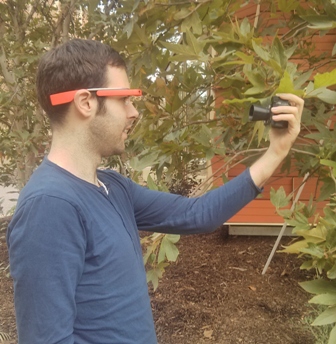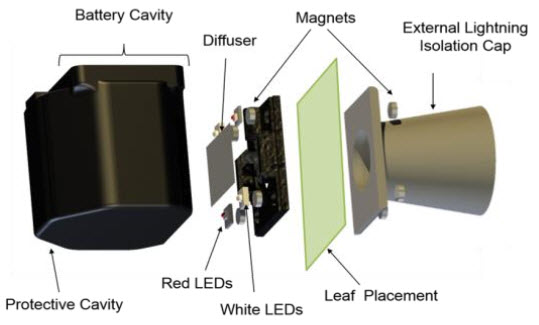Google Glass app analyzes plants’ health in seconds
February 10, 2015

A Google Glass app and illuminator allow researchers to analyze chlorophyll concentration in a leaf without harming the plant (credit: UCLA)
Scientists from UCLA’s California NanoSystems Institute have developed a custom-designed Google Glass Android app that, when paired with a handheld device, enables the wearer to quickly analyze the health of a plant without damaging it or requiring expensive lab equipment and expertise.
The app analyzes the concentration of chlorophyll — the substance in plants responsible for converting sunlight into energy. Reduced chlorophyll production in plants can indicate degradation of water, soil, or air quality.
One current method for measuring chlorophyll concentration requires removing some of the plant’s leaves, dissolving them in a chemical solvent and then performing the chemical analysis. With the new system, leaves are examined and then left functional and intact.
The system, developed by at team led by Aydogan Ozcan, associate director of the UCLA California NanoSystems Institute, uses an image captured by the Google Glass camera to measure the chlorophyll’s light absorption in the green part of the optical spectrum.
Simple DIY plant diagnostics

Schematic of custom-developed 3D-printed leaf holder and illuminator device (credit: Bingen Cortazar et al./Lab on a Chip)
The device is simple to use. You insert the leaf into a slot in the illuminator, red and white LEDs emit light that enhances the leaf’s transmission image contrast, indoors or out, regardless of environmental lighting conditions.
Glass photographs the leaf in both colors and sends an enhanced JPEG image wirelessly to a remote server, which processes the data from the image and sends back a chlorophyll concentration reading (“SPAD index”) — all in less than 10 seconds. GPS and time data is also provided.
You can produce the main body of the handheld illuminator unit using 3D printing. It runs on three AAA batteries and with a small circuit board added, it can be assembled for less than $30.
The research, led by Aydogan Ozcan, associate director of the UCLA California NanoSystems Institute and Chancellor’s Professor of Electrical Engineering and Bioengineering at the UCLA Henry Samueli School of Engineering and Applied Science, was published online by the Royal Society of Chemistry journal Lab on a Chip.
“One pleasant surprise we found was that we used five leaf species to calibrate our system, and that this same calibration worked to accurately detect chlorophyll concentration in 15 different leaf species without having to recalibrate the app,” Ozcan said. “This will allow a scientist to get readings walking from plant to plant in a field of crops, or look at many different plants in a drought-plagued area and accumulate plant health data very quickly.”
The system could replace relatively costly and bulky laboratory instruments. Ozcan said that the convenience, speed and cost-effectiveness of the new system could aid scientists studying the effects of droughts and climate change in remote areas.
Ozcan’s lab specializes in computational imaging, sensing and diagnostic devices for various mobile-health and telemedicine applications. Its previous work includes quick analysis of food samples for allergens, water samples for heavy metals and bacteria and cell counts in blood samples. The research team has devised a way to use Google Glass to process diagnostic test results, and an app and attachment that converts a smartphone into a fluorescence microscope for imaging single viruses and individual DNA molecules.
Support for Ozcan’s lab is provided by the Presidential Early Career Award for Scientists and Engineers, the Army Research Office Life Sciences Division, the National Science Foundation, the Office of Naval Research, the Howard Hughes Medical Institute and the National Institutes of Health.
Abstract for Quantification of plant chlorophyll content using Google Glass
Measuring plant chlorophyll concentration is a well-known and commonly used method in agriculture and environmental applications for monitoring plant health, which also correlates with many other plant parameters including, e.g., carotenoids, nitrogen, maximum green fluorescence, etc. Direct chlorophyll measurement using chemical extraction is destructive, complex and time-consuming, which has led to the development of mobile optical readers, providing non-destructive but at the same time relatively expensive tools for evaluation of plant chlorophyll levels. Here we demonstrate accurate measurement of chlorophyll concentration in plant leaves using Google Glass and a custom-developed software application together with a cost-effective leaf holder and multi-spectral illuminator device. Two images, taken using Google Glass, of a leaf placed in our portable illuminator device under red and white (i.e., broadband) light-emitting-diode (LED) illumination are uploaded to our servers for remote digital processing and chlorophyll quantification, with results returned to the user in less than 10 seconds. Intensity measurements extracted from the uploaded images are mapped against gold-standard colorimetric measurements made through a commercially available reader to generate calibration curves for plant leaf chlorophyll concentration. Using five plant species to calibrate our system, we demonstrate that our approach can accurately and rapidly estimate chlorophyll concentration of fifteen different plant species under both indoor and outdoor lighting conditions. This Google Glass based chlorophyll measurement platform can display the results in spatiotemporal and tabular forms and would be highly useful for monitoring of plant health in environmental and agriculture related applications, including e.g., urban plant monitoring, indirect measurements of the effects of climate change, and as an early indicator for water, soil, and air quality degradation.